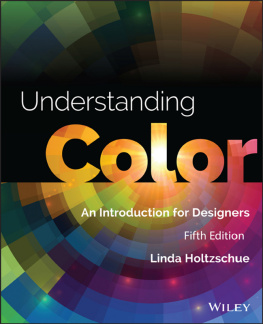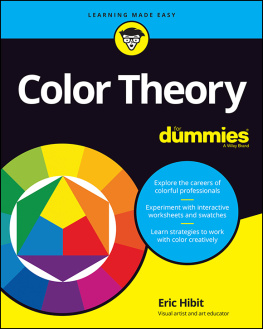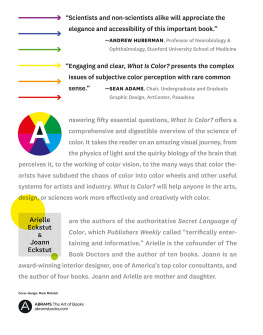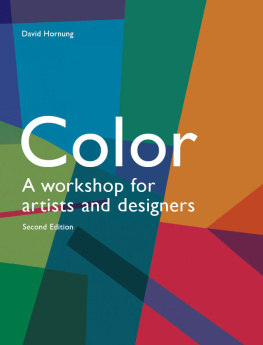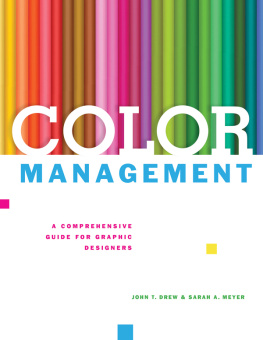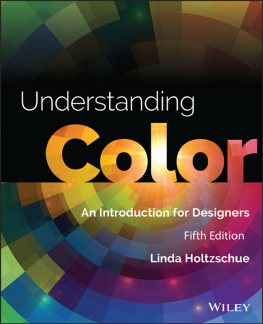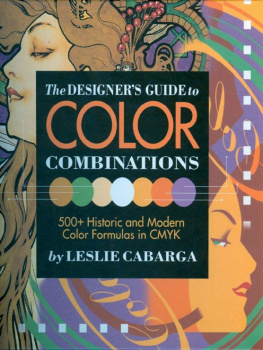
UNDERSTANDING COLOR
An Introduction for Designers
Fifth Edition
Linda Holtzschue
Cover image: art_of_sun/Shutterstock
Cover design: Wiley
This book is printed on acid-free paper.
Copyright 2017 by John Wiley & Sons, Inc. Hoboken, New Jersey. All rights reserved.
Published by John Wiley & Sons, Inc., Hoboken, New Jersey
Published simultaneously in Canada
No part of this publication may be reproduced, stored in a retrieval system, or transmitted in any form or by any means, electronic, mechanical, photocopying, recording, scanning, or otherwise, except as permitted under Section 107 or 108 of the 1976 United States Copyright Act, without either the prior written permission of the Publisher, or authorization through payment of the appropriate per-copy fee to the Copyright Clearance Center, 222 Rosewood Drive, Danvers, MA 01923, (978) 7508400, fax (978) 6468600, or on the web at www.copyright.com. Requests to the Publisher for permission should be addressed to the Permissions Department, John Wiley & Sons, Inc., 111 River Street, Hoboken, NJ 07030, (201) 7486011, fax (201) 7486008, or online at www.wiley.com/go/permissions.
Limit of Liability/Disclaimer of Warranty: While the publisher and author have used their best efforts in preparing this book, they make no representations or warranties with the respect to the accuracy or completeness of the contents of this book and specifically disclaim any implied warranties of merchantability or fitness for a particular purpose. No warranty may be created or extended by sales representatives or written sales materials. The advice and strategies contained herein may not be suitable for your situation. You should consult with a professional where appropriate. Neither the publisher nor the author shall be liable for damages arising herefrom.
For general information about our other products and services, please contact our Customer Care Department within the United States at (800) 7622974, outside the United States at (317) 5723993 or fax (317) 5724002.
Wiley publishes in a variety of print and electronic formats and by print-on-demand. Some material included with standard print versions of this book may not be included in e-books or in print-on-demand. If this book refers to media such as a CD or DVD that is not included in the version you purchased, you may download this material at http://booksupport.wiley.com. For more information about Wiley products, visit www.wiley.com.
Library of Congress Cataloging-in-Publication Data:
Names: Holtzschue, Linda, author.
Title: Understanding color : an introduction for designers / Linda Holtzschue.
Description: Fifth Edition. | Hoboken : Wiley, 2017. | Includes bibliographical references and index.
Identifiers: LCCN 2016029123 (print) | LCCN 2016029930 (ebook) | ISBN 9781118920787 (pbk.) | ISBN 9781118920800 (pdf) | ISBN 9781118920794 (epub)
Subjects: LCSH: Color in design.
Classification: LCC NK1548 .H66 2017 (print) | LCC NK1548 (ebook) | DDC
701'.85dc23
LC record available at https://lccn.loc.gov/2016029123
DEDICATION
To my children, Alison, Adam, and Sara, and the wonderful partners they have brought into our lives; to my grandchildren, Amanda, Katherine, and Daniel; and most of all to my husband Karl, whose patience and support has made these books possible.
PREFACE
More changes have taken place in the world of color in the last few decades than have occurred over the last few centuries. The most obvious onethat drawing is now done in lightis only one aspect of this seismic shift. Color is an ever-changing, ever-advancing world, and at times a very confusing one.
This book is written for everyone who deals with coloruses it, specifies it, or just plain looks at it. It is written for design students and sign painters, architects and carpet salesmen, graphic designers and magicians. It is a road map to the relationships between colors and to the relationship between the colors of light and the colors of the real world. It is a guide to using colors freely and creatively without dependence on complicated theories or systems. This is a book about learning to see.
This book includes a workbook component that is available online at www.wiley.com/go/understanding color5e.
ACKNOWLEDGMENTS
This fifth edition of Understanding Color would not have been possible without the generosity and help of friends, family, and colleagues both old and new. I could not have done this book without the contributions of Laurent de Brunhoff, Phyllis Rose, Carin Goldberg, Ron Lubman, Kenneth Charbonneau, Mark Stevenson, Donna Frost, David Setlow, Bob Stein of VisiBone, Andrew Lathrop, Deb Slatkin of Neonworks, Sharon Griffis of Color Marketing Group, Leslie Harrington of the Color Association of the United States, Stephen Gerould, X-Rite Corporation, Dan Brammer, Adobe Systems, Farrow and Ball, Coats and Clark, Elizabeth Eakins, Zoffany/Sanderson, Ryan Ford of Colwell Industries, Eve Ashcraft, and especially Jennifer Perman, whose illustrations continue to enhance so many pages. To all of these, and to those I have inadvertently missed, my heartfelt thanks.
AN INTRODUCTION TO COLOR STUDY
The Experience of Color / Color Awareness / The Uses of Color / Color-Order Systems / Color Study
Color is essential for life.
Frank H. Mahnke
Color is stimulating, calming, expressive, disturbing, exuberant, symbolic. It pervades every aspect of life, embellishes the ordinary, and gives beauty and drama to everyday objects. If black-and-white images bring the news of the day, color writes the poetry.
The romance of color exists for everyone, but color plays a far more important role for design professionals. Forms, colors, and their arrangement are the foundation elements of design, and of these, color is arguably the most powerful weapon in the designer's arsenal. A skilled colorist understands how colors are seen, when and why they seem to change, the variety of their meanings and suggestive powersand how to apply that knowledge to enhance the marketability of products. Whether that product is a graphic design, a sweater, an airplane seat, a kitchen utensil, a laptop, a wedding cake, or anything else, color will play a great part in determining its success or failure in the consumer marketplace. For designers, color means business.
The Experience of Color
Color is, first, a sensory event. Every color experience begins as a physiological response to a stimulus of light. Colors of light are experienced in two very different ways. The colors on a monitor screen are seen as direct light. The colors of the real worldof printed pages, physical objects, and the surrounding environmentare seen as reflected light.
The perception of colors seen as direct light is straightforward: wavelengths of light reach the eye directly from a light source. The experience of real-world color is a more complex event. Real-world colors are seen indirectly, as light reflected from a surface. For tangible objects and printed pages, light is the cause of color, colorants (like paints, inks, or dyes) are the means used to generate color, and the colors that are seen are the effect.
Colors that are experienced as reflected light are unstable. Move a red object from one kind of illumination to anotherfrom daylight to fluorescent lighting, for exampleand its apparent color will undergo a noticeable shift. The same red paint applied to smooth plaster will not seem the same on rough stucco. A single color can appear as two or even more different colors simply by changing its placement against other colors. Two identical oranges, one laid on a red tablecloth and the other on a yellow one, will seem different: the first more yellow-orange, the other more red-orange.
Next page
